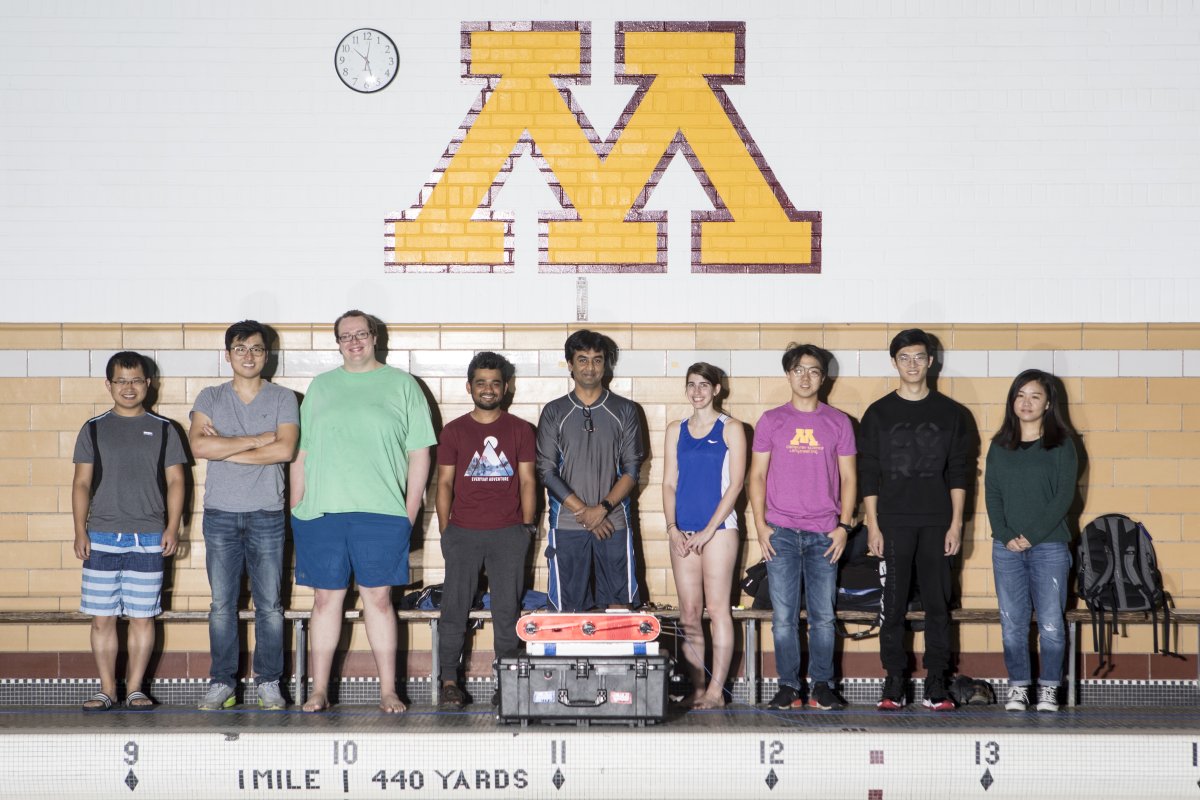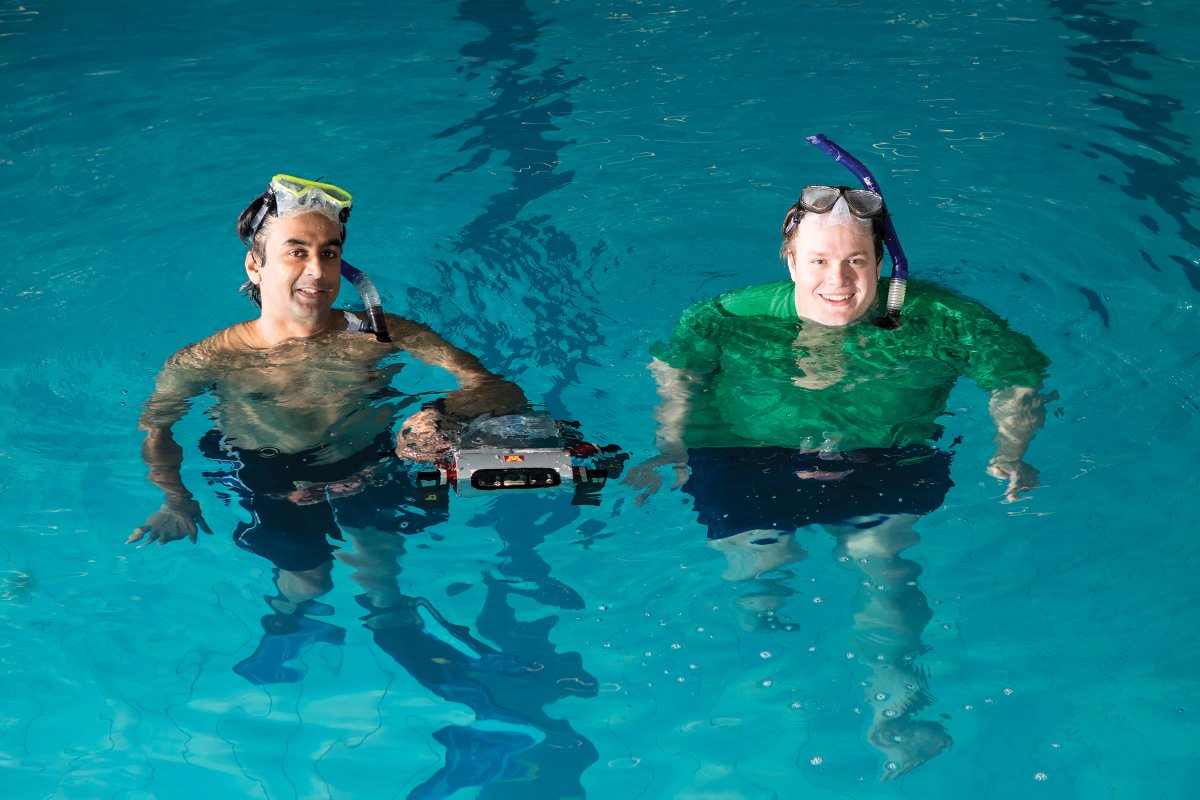Tinkering in different buoyancies

Above: The IRV team one of the University of Minnesota's swimming pools. Watch the video in this feature story to learn more about this team and see Minnebot in action.
CSE graduate student focuses on robot-to-human communication in the IRV Lab
November 9, 2018
What has six legs, lives at the University of Minnesota, and spends time at the pool once a month? The answer: Minnebot, the amphibious robot that ultimately could help improve our knowledge of water quality in the state—and beyond.
Michael Fulton, a second-year Ph.D. student in the Department of Computer Science and Engineering, “met” the robot in September 2017, a few months after its arrival to the Interactive Robotics and Vision (IRV) Lab on the Twin Cities campus from Independent Robotics Inc., a startup in Montréal, Canada.
In the year since, Fulton said, the autonomous submersible has changed a lot.
“I don’t think it had even hit the water when it got here, except maybe a test in a small bath,” Fulton said.
Since then, the IRV Lab team—five Ph.D. students plus about five undergrads at any given time—has worked constantly on Minnebot: testing, adjusting, upgrading. The lab is directed by Fulton's advisor: Junaed Sattar, an assistant professor and MnDrive faculty at the University of Minnesota.
“Water quality, pollution control, and aquatic invasive species are really interesting to me,” Fulton said.
“Municipal water monitoring, for example, is one application I’m studying,” he said. “I’ve read a lot of DNR water quality reports, which are based on human measurements. If we could use Minnebot to do that same job, we could potentially increase the number of readings and improve the state of our waters.”
But there’s plenty to do before Minnebot is ready to fulfill its purpose.
“It’s definitely a work in progress,” Fulton said. “There are always new innovations happening. I think everyone in robotics, to a certain extent, is a tinkerer— that’s just the way our brains work. We’re never fully satisfied.”

Much of the group’s work revolves around Sattar’s studies involving human-to-robot communication, or enabling humans and Minnebot to communicate with each other. For instance, one student in the lab has developed a hand-gesture interface, where you make gestures to the robot and control it that way.
Fulton, on the other hand, is doing the reverse.
“I’m working on robot-to-human interface—using the robot’s motion, starting with having the robot nod its head or shake its head and moving on to more complicated things, like pointing,” he said.
“It needs to be efficient, it needs to be natural, and it needs to be foolproof—especially underwater,” Fulton explained.
Another challenge that’s unique to underwater robots is vision—being able to obtain usable images to collect data (for instance, on water quality).
“The trouble is that underwater, most images are distorted,” Fulton said. “You have turbidity, you have varying light conditions, you have algae. But we’ve done some fantastic work on improving underwater image quality.”
Click on this video to watch Minnebot in action and learn more about the IRV Lab in the new Gemini-Huntley Robotics Research Laboratory.
Trips to the pool and Barbados
The group brings Minnebot to the University Recreation and Wellness Center monthly for a full day of pool trials. That entails hours of packing up before and after, Fulton said. In June, they also brought it to Lake Nokomis in south Minneapolis for more of a real-world experience. And in February, Fulton and Sattar, his faculty advisor, along with other IRV Lab colleagues, will bring Minnebot on its second trip to Barbados for trials at the Bellairs Research Institute.
While Barbados is a great place to be in late winter, Fulton said, the week is a “marathon” of 16-hour workdays.
“But [the 2018 trip] was a really great experience because, up until that point, it hadn’t been in saltwater. Salt and freshwater have entirely different buoyancies,” he explained. “We have lead plates and small anodized weights that we screw onto it to weigh it down. Our first day, we spent the entire time just doing that.”
Later the group discovered that the hand-gesture communications they’d been using back on campus weren’t working.
“You try something in the pool and it works fine, then you take it out to the ocean and it doesn’t work,” he said. “So you recalibrate. You stay up late fixing things, and you try again the next day.”
Overall, however, “our field trials have gone pretty well,” he added.
“Our work on underwater robotics has resulted in collaborations with, and visits from, other labs in spite of us being a young lab,” Fulton said
Fulton is grateful to have followed Sattar, his undergraduate professor and mentor at Clarkson University in upstate New York, to the Twin Cities.
“I applied to other schools, but I knew: If I get into the University of Minnesota, I’m going,” he said. “Our work in the IRV Lab is very exciting. You learn anything and you pass it on. I’ve had a few experiences trading ideas with professors, and it’s great—I’m so glad I decided to come here.”
To learn more about the University of Minnesota's Interactive Robotics and Vision Lab, visit the IRV website.
Story by Susan Maas
For more student research experiences:
Read about CSE student Maria Camila Merino Franco's work with "floating islands" in “Letting nature do its work.”
Read about graduate student Mrugank Bhatt work with cavitation in “More to bubbles than you think.”
If you’d like to support student research opportunities, visit our CSE giving page.
